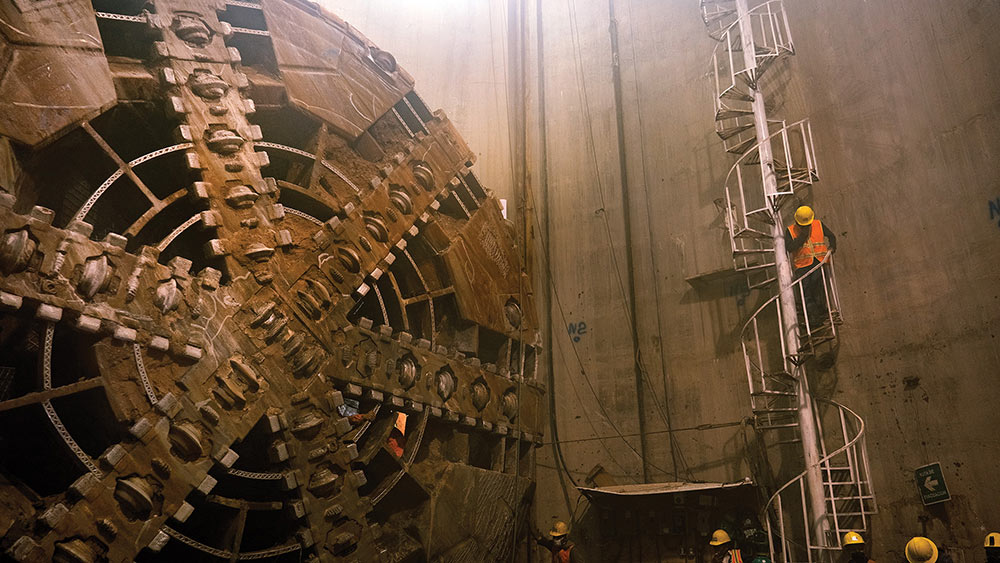Emisor Oriente breakthrough in Mexico City 21 Mar 2019
After the deepest assembly of a TBM on record for Mexico, breakthrough has occurred on one of the most difficult sections of the complex Emisor Oriente tunnel, a 62km (39 mile) long conduit that will revamp wastewater treatment for more than 21.2 million people in Mexico City. A ceremony greeted the 8.93m (29.3ft) diameter Robbins EPBM as it broke through for contractor Ingenieros Civiles Asociados.
The 6km (3.7 mile) long Lot 5, one of six lots at Emisor Oriente, required the Robbins machine to be launched from the deepest civil works shaft in Mexico, at 150m (492ft), and to excavate mixed face conditions and abrasive basalt rock.
“Robbins field service personnel operated the equipment accurately and were able to detect and fix any problems swiftly to reduce downtime on the excavation,” said José Adolfo Méndez Colorado, Superintendente de Maquinaria for contractor Ingenieros Civiles Asociados (ICA).
The complexity of the ground conditions required the correct concentration and selection of polymers. “There were some issues with the screw conveyor conveying mixed ground and also in the articulation system, which were overcome,” said Colorado.
“This machine has worked in two very different worlds,” said Roberto Gonzalez, General Manager for Robbins Mexico. In 2011 the machine originally slated for Lot 5 was fast-tracked to bore a 3.9km (2.4 mile) long section of Lot 1b—a critical part of the line that needed to become operational right away to prevent chronic seasonal flooding. “The EPB proved itself while using conveyors in the sticky clays of Mexico City with very high percentages of water content, up to 400%,” said Gonzalez. The machine achieved rates of up to 592.5m (1,944ft) in one month—considered a record among the six EPBs (three of them Robbins) used on the project. After completing the bore in just 15 months, the machine was sent to the Lot 5 site, where modifications were made for a section of mixed ground and rock.
Modifications included a high-pressure man lock capable of withstanding 7 bars, chromium carbide wear plates added to the screw conveyor, and grizzly bars added to the cutterhead along with heavy duty cutting tools.
The machine was assembled in a 28m (92ft) long assembly chamber at the bottom of the launch shaft and commissioned in August 2014, requiring all back-up gantries to remain at the surface. Two months later in October 2014, after advancing 150m (492ft), the machine and its back-up gantries were completely assembled in the tunnel. One month later, the continuous conveyor system was installed and running. “The assembly of the EPB at Lot 5 has the record of the deepest assembly of a TBM in Mexico. It required great coordination of ICA engineers, high capacity cranes for the assembly and human resources in order to keep to the ten-week schedule for assembly,” said Gonzalez.
With tunneling at Lot 5 now officially concluded there is one more breakthrough remaining before the Emisor Oriente line is complete: An 8.93m (29.3ft) Robbins EPB operating at Lot 4 is scheduled to break through this spring. A third Robbins EPB operating at Lot 3 completed its tunnel in 2018.
The Túnel Emisor Oriente (TEO) is the answer to more than 100 years of sinking in Mexico City as the result of drained lake beds and general lowering of the water table. The city’s buildings, main streets and other structures have sunk more than 12m (39ft) in that time, and much of the area is vulnerable to flooding. At the same time the area’s gravity-fed wastewater lines have lost their slope and are severely under capacity.
Once tunneling is complete, the resulting TEO will expand capacity, adding 150m3/sec (5,297ft3/sec) to the Valley of Mexico system, as well as alleviating the risk of flooding in critical areas. It will also convey wastewater to the country’s largest wastewater treatment plant. The massive tunnel includes 24 shafts, ranging from 23m to 150m (75 to 492ft) in depth, plus an exit portal at the treatment plant in the Municipality of Atotonilco, in the state of Hidalgo.
References
- Mexico City manages mega drainage – TunnelTalk, May 2013
- Robbins EBPMs heading for Mexico City – TunnelTalk, February 2010
- Robbins EPBMs to drive Mexico City drainage – TunnelTalk, November 2008
|
|
|
|
|
Add your comment
- Thank you for taking the time to share your thoughts and comments. You share in the wider tunnelling community, so please keep your comments smart and civil. Don't attack other readers personally, and keep your language professional.





